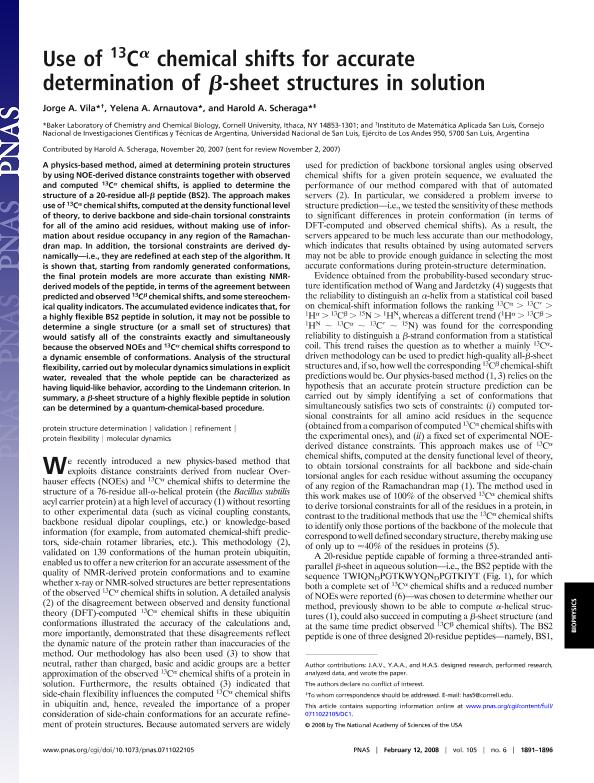Mostrar el registro sencillo del ítem
dc.contributor.author
Vila, Jorge Alberto

dc.contributor.author
Arnautova, Yelena A.

dc.contributor.author
Scheraga, Harold A.

dc.date.available
2021-06-30T13:34:27Z
dc.date.issued
2008-02
dc.identifier.citation
Vila, Jorge Alberto; Arnautova, Yelena A.; Scheraga, Harold A.; Use of 13Ca chemical shifts for accurate determination of beta-Sheet structures in solution; National Academy of Sciences; Proceedings of the National Academy of Sciences of The United States of America; 105; 6; 2-2008; 1891-1896
dc.identifier.issn
0027-8424
dc.identifier.uri
http://hdl.handle.net/11336/135150
dc.description.abstract
A physics-based method, aimed at determining protein structures by using NOE-derived distance constraints together with observed and computed 13Cα chemical shifts, is applied to determine the structure of a 20-residue all-β peptide (BS2). The approach makes use of 13Cα chemical shifts, computed at the density functional level of theory, to derive backbone and side-chain torsional constraints for all of the amino acid residues, without making use of information about residue occupancy in any region of the Ramachandran map. In addition, the torsional constraints are derived dynamically—i.e., they are redefined at each step of the algorithm. It is shown that, starting from randomly generated conformations, the final protein models are more accurate than existing NMR-derived models of the peptide, in terms of the agreement between predicted and observed 13Cβ chemical shifts, and some stereochemical quality indicators. The accumulated evidence indicates that, for a highly flexible BS2 peptide in solution, it may not be possible to determine a single structure (or a small set of structures) that would satisfy all of the constraints exactly and simultaneously because the observed NOEs and 13Cα chemical shifts correspond to a dynamic ensemble of conformations. Analysis of the structural flexibility, carried out by molecular dynamics simulations in explicit water, revealed that the whole peptide can be characterized as having liquid-like behavior, according to the Lindemann criterion. In summary, a β-sheet structure of a highly flexible peptide in solution can be determined by a quantum-chemical-based procedure.
dc.format
application/pdf
dc.language.iso
eng
dc.publisher
National Academy of Sciences

dc.rights
info:eu-repo/semantics/openAccess
dc.rights.uri
https://creativecommons.org/licenses/by-nc-sa/2.5/ar/
dc.subject
MOLECULAR DYNAMICS
dc.subject
PROTEIN FLEXIBILITY
dc.subject
PROTEIN STRUCTURE DETERMINATION
dc.subject
REFINEMENT
dc.subject
VALIDATION
dc.subject.classification
Física Atómica, Molecular y Química

dc.subject.classification
Ciencias Físicas

dc.subject.classification
CIENCIAS NATURALES Y EXACTAS

dc.title
Use of 13Ca chemical shifts for accurate determination of beta-Sheet structures in solution
dc.type
info:eu-repo/semantics/article
dc.type
info:ar-repo/semantics/artículo
dc.type
info:eu-repo/semantics/publishedVersion
dc.date.updated
2020-09-24T14:26:11Z
dc.journal.volume
105
dc.journal.number
6
dc.journal.pagination
1891-1896
dc.journal.pais
Estados Unidos

dc.journal.ciudad
Washington DC
dc.description.fil
Fil: Vila, Jorge Alberto. Consejo Nacional de Investigaciones Científicas y Técnicas. Centro Científico Tecnológico Conicet - San Luis. Instituto de Matemática Aplicada de San Luis "Prof. Ezio Marchi". Universidad Nacional de San Luis. Facultad de Ciencias Físico, Matemáticas y Naturales. Instituto de Matemática Aplicada de San Luis "Prof. Ezio Marchi"; Argentina. Cornell University; Estados Unidos
dc.description.fil
Fil: Arnautova, Yelena A.. Cornell University; Estados Unidos
dc.description.fil
Fil: Scheraga, Harold A.. Cornell University; Estados Unidos
dc.journal.title
Proceedings of the National Academy of Sciences of The United States of America

dc.relation.alternativeid
info:eu-repo/semantics/altIdentifier/doi/https://doi.org/10.1073/pnas.0711022105
dc.relation.alternativeid
info:eu-repo/semantics/altIdentifier/url/https://www.pnas.org/content/105/6/1891
Archivos asociados
